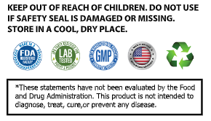B6 Toxicity
While it is crucial for health, excessive intake of B6, particularly through supplements, can lead to toxicity with significant health implications.
Vitamin B6, or pyridoxine, is an essential water-soluble vitamin critical for numerous physiological functions, including neurotransmitter synthesis, protein metabolism, and hemoglobin production. Although, most people take vitamin B6 supplements without experiencing any negative side effects, there is a risk vitamin B6 toxicity due to unintentional overconsumption.
Please review the following recommendations to stay within safe intake levels.
Tolerable Upper Intake Level (UL) for Vitamin B6
In the United States, the Institute of Medicine (IOM)* has established a Tolerable Upper Intake Level (UL) for vitamin B6 to help mitigate the risk of adverse effects from excessive intake. The UL for adults aged 19 years and older is set at 100 milligrams (mg) per day. This threshold applies to synthetic forms of B6 found in dietary supplements and fortified foods but does not include naturally occurring B6 in whole foods. However, the European Food Safety Administration (EFSA) has established a Tolerable Upper Intake Level (UL) for B6 of only 12mg/day.
The recommended dosage of Lebombo’s Bone Brain Support Complex contains 12mg of B6.
*The Institute of Medicine (IOM) is not a healthcare accrediting agency but a part of the National Academy of Sciences and chartered by Congress. The IOM’s work includes defining healthcare quality and providing advice on how to improve it.
Symptoms of Vitamin B6 Toxicity
Excessive intake of vitamin B6, typically from high-dose supplements, can lead to a condition called pyridoxine toxicity. Symptoms are primarily neurological and may include:
- Peripheral neuropathy: Numbness, tingling, or pain in the hands and feet, often described as a “pins and needles” sensation.
- Motor control issues: Difficulty coordinating movements due to nerve damage.
- Sensitivity to sunlight: Increased susceptibility to photosensitivity and skin irritation.
- Fatigue and irritability: Non-specific symptoms related to overall nerve dysfunction.
In severe cases, long-term overconsumption can lead to irreversible nerve damage.
Sources of Vitamin B6 in the Diet
Vitamin B6 is widely available in many foods, which makes dietary deficiencies rare in developed countries. Common natural sources include:
- Poultry, fish, and meat: Chicken, turkey, salmon, and beef are rich in B6.
- Fruits and vegetables: Bananas, potatoes, and spinach contain moderate amounts of B6.
- Fortified cereals: Many breakfast cereals are enriched with synthetic B6 to enhance nutritional value.
Hidden Sources of Excessive B6
While dietary intake of B6 from natural food sources rarely poses a risk of toxicity, individuals may unknowingly consume excessive amounts through other means, such as:
- Dietary supplements: High-dose B6 supplements marketed for energy, mood enhancement, or immune support can lead to overconsumption.
- Energy drinks and bars: Many energy drinks and protein bars are fortified with synthetic B6, contributing to cumulative intake.
- Multivitamins: Routine use of multivitamins with high B6 content can push total daily intake beyond the UL.
Preventing Vitamin B6 Toxicity
To avoid B6 toxicity:
- Monitor supplement use: Be cautious with high-dose B6 supplements and consult a healthcare provider if you’re considering doses above the Recommended Dietary Allowance (RDA).
- RDA for adults: 1.3-1.7 mg/day depending on age and sex.
- Check labels: Review the B6 content of fortified foods, energy drinks, and dietary supplements to ensure cumulative intake stays below the UL.
- Focus on natural sources: Prioritize obtaining B6 from whole foods, which provide the vitamin in its natural form alongside other beneficial nutrients.
- Seek medical advice: If you experience symptoms consistent with B6 toxicity, such as numbness or tingling, consult a healthcare provider immediately.
Conclusion
While vitamin B6 is essential for good health, excessive intake through supplements or fortified foods can lead to toxicity with potentially severe neurological symptoms. By staying informed about sources of B6 and adhering to the established Tolerable Upper Intake Level, individuals can enjoy the benefits of this vital nutrient without risking their health.
Responsible supplementation and an emphasis on natural food sources are key strategies for maintaining safe and balanced levels of all vitamins.

